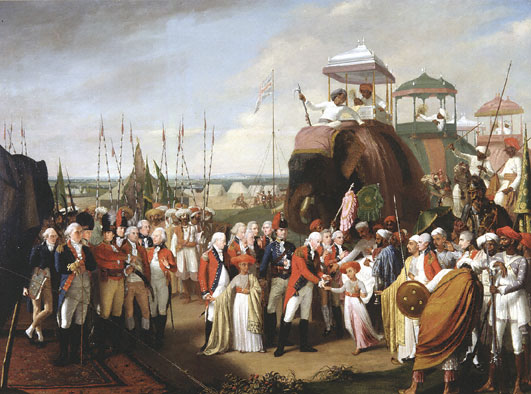
First Foot Guards
The Tippoo's Tiger
A curious artifact in the Victoria & Albert Museum
in London

This strange item
represents a tiger in the act of
mauling a prostrate Redcoat.
It was found in 1799 in the palace at Seringapatam in Mysore, in India, and was presented to the museum of the East India Company by the army, ultimately finding its way into the collection of the Victoria and Albert Museum in South Kensington, London.
It was a favorite of the Tipoo Sultan, who was sovereign of Mysore. In a series of wars, he sorely pressed the British Army, but was finally destroyed by Cornwallis at the Siege of Seringapatam in 1799.
Tipoo's tiger is an automaton, combining movement with two windpipe mechanisms. It also contains a manual organ.
The crank on the animal's shoulder turns a shaft within the body. A wire connects to this shaft, which passes down from the tiger between his fore-paws into the soldier's chest, where it works a pair of bellows, forcing air through a pipe that exits through the soldier's mouth and emits a whistling wail. The soldier's hand covers his mouth, but when the air is forced through the pipe the arm rises in a manner which the artist intended to show helplessness.
The wail is repeated as often as the handle is turned, and while this process is going on, an endless screw on the shaft turns a worm gear slowly round, which has four cams. Each cam progressively raises the actuator of a larger bellows in the tiger's head. When the bellows is full, a lead weight falls, closes the bellows suddenly, expelling air through two pipes which emit a harsh two-tone growl.
The man in the meantime continues his wailing, and after a dozen cries the tiger's growl repeats.
The tiger's body contains a small organ that is unconnected to the growling and wailing mechanism. You can see the keys exposed. The strange keyboard has 18 ivory keys. Behind the keys are two rows of copper pipes. Each row can be made silent via stops that emerge at the tiger's rear end. Behind the pipes, on the other flank of the tiger, is another bellows that provides wind for the organ.
The comical thing about this automaton is the soldier is in a ludicrous position: his left hand is placed on his mouth; his right arm in soldierly attitude is stiff by his side; his legs are stiff, and his feet, with well-blacked shoes and yellow buckles, are turned out as though upon drill. Interestingly he has a hatt-capp, with a low crown, and broad brim. His coat is scarlet, adorned with large roses, and two gilded epaulettes. His breeches are green, and his stockings yellow. Experts think that the automaton might not have been presented new to the Tippoo. It might have previously represented a Dutchman.
The Tippoo Sultan was so delighted that he is said to have passed hours in his music-room with an attendant turning the handle of the machine. The fun ended in 1799 when Cornwallis' troops stormed Seringapatam, and the Tippoo was killed in the conflict.

Lieutenant
General Lord Cornwallis receiving
Tipoo Sultanís sons as hostages.
Robert Home, circa 1793, exhibited at the Royal Academy 1797.
The delivery of Tipoo Sultan of Mysoreís sons as hostages to Lord Cornwallis, Governor General of India, was part of the peace settlement that followed the 3rd Mysore War (1790-1792). The artist accompanied Cornwallis's army, producing numerous sketches of incidents in the campaign. He also included a self-portrait, on the extreme left of this painting.
See the Portrait of Cornwallis in the National Portrait Gallery
Key in 'Cornwallis'
Click
More on Cornwallis
Click
Return to homepage
Click